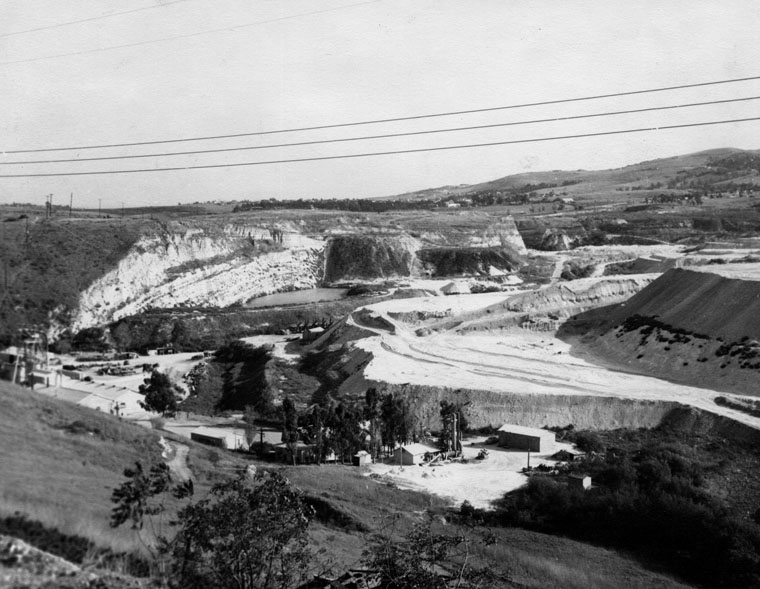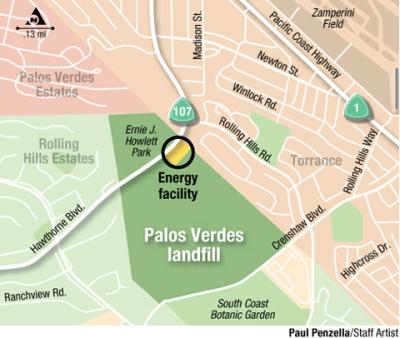During the early 1900’s the Dicalite Company began mining diatomaceous earth in the area now occupied by the South Coasrt Botanical Gardens off of Crenshaw Blvd, the former Palos Verdes Landfill site between Hawthorne and Crenshaw, and Ernie Howlett Park off of Hawthorne Blvd, , but at this time it was mostly surface mining. By 1929, open-pit mining was being pursued. In 1944 the mine was sold to the Great Lakes Carbon Company and mining began in earnest.
By 1956, production of the mine declined and the site was sold to the County of Los Angeles, which then converted the site to a Sanitary Landfill in 1957 until it was closed. On Dec. 31, 1980, the Palos Verdes landfill officially closed after having accepted a total of 24 million tons of trash since its opening.Partial restoration of the site began with the opening of South Coast Botanic Garden on the eastern end of the site in April 1961, and the construction of Ernie Howlett Park on the site’s western side, a project fully completed in 1982. The site between Hawthorne and Crenshaw , however, still remains unimproved.

1953 Open pit dicalite mine in Palos Verdes (LA Times photos)

Aerial view of open pit mine operations in Palos Verdes

 Aerial view today looking north towards Torrance with Hawthorne Blvd on the left, and Crenshaw on the right.
Aerial view today looking north towards Torrance with Hawthorne Blvd on the left, and Crenshaw on the right.
Recently, the County had considered constructing a golf course, however local opposition killed the project. (See Palos Verdes Golf for a description of this proposed project ). An energy facility converts methane gas from the decomposing trash into energy on-site.
My husband and I are currently leading an effort to have the County of Los Angeles construct a dog park on the landfill site just north of Palos Verdes Drive North and off of Hawthorne Blvd.
The area known as Butcher Hill , beginning in 1944, before Hawthorne was extended past the current Via Valmonte in 1965, was a diatomaceous earth (dicalite) mine, that extended into the area now occupied by the Hillside Village shopping center. This is the last remnants of the dicalite open pit mining that had taken place on the north side of the Palos Verdes Peninsula.This mine had been leased by the Great Lakes Carbon Corporation from the Vanderlip family, that still owned approx.6,800 acres of the original 16,000 acres retained by Frank Vanderlip when he sold the land which made up the Palos Verdes Project. Another rich deposit was known to exist on a 165-acre tract near the crest of the Peninsula. For two years, the Great Lakes Carbon Corporation had been unsuccessfully attempting to purchase this property from the Vanderlip family. Finally, in July 1953, the Great Lakes Carbon Corporation in a stock transaction purchased all 6,800 acres from the Palos Verdes Corporation, the Vanderlip family’s corporation. The Great Lakes Carbon Corporation, realizing that this land would be more valuable if developed,then created a master plan for the acreage, which later became the cities of Rancho Palos Verdes, Rolling Hills, Rolling Hills Estates, and the unincorporated area known as Palos Verdes Peninsula.

Remnants ofr Diatomaceous earth (dicalite) mine at corner of Hawthorne and Via Valmonte
For more information about Palos Verdes and South Bay Real Estate and buying and selling a home on the Palos Verdes Peninsula, visit my website at https://www.maureenmegowan.com . I try to make this the best real estate web blog in the South Bay Los Angeles and the Palos Verdes Peninsula. I would love to hear your comments or suggestions.




